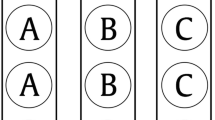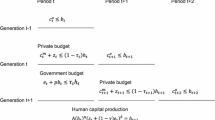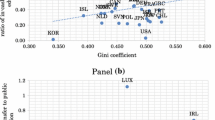Abstract
Pro-social preferences are thought to play a significant role in solving society’s collective action problems of providing public goods and reducing public bads. Societies can benefit by deliberately instilling and sustaining such preferences in their members. We construct a theoretical model to examine an intergenerational education process for this. We consider both a one-time action of this kind and a constitution that establishes a steady state, and compare the two.
Access this chapter
Tax calculation will be finalised at checkout
Purchases are for personal use only
Similar content being viewed by others
Notes
- 1.
Induction in this context is a mild form of discipline technique. Hoffman defines and explains it as follows: “When children harm or are about to harm someone—the parent, a sibling, a friend—… indicate[s] implicitly or explicitly that the act is wrong and that the child has committed an infraction. … This creates the condition for feeling empathy-based guilt. Hoffman (2000, pp. 150–151).
- 2.
- 3.
The problem of the commons, where the issue is how to dissuade individuals from creating a public bad, is the mirror image of this, and can be analyzed by similar methods. In other contexts, sufficiently pro-social preferences may lead to a coordination or “assurance” game. Such more complex interaction topologies are subject of our ongoing work.
- 4.
See Friedman (1962, p. 191) for an early argument along these lines in favor of government action to alleviate poverty.
References
Akcay, E., Van Cleve, J., Feldman, M. W., & Roughgarden, J. (2009). A theory for the evolution of other-regard integrating proximate and ultimate perspectives. Proceedings of the National Academy of Sciences of the United States of America, 106, 19061–19066.
Arrow, K. J., & Levin, S. A. (2009). Intergenerational resource transfers with random offspring numbers. Proceedings of the National Academy of Sciences of the United States of America, 106, 13702–13706.
Bisin, A., & Verdier, T. (2001). The economics of cultural transmission and the dynamics of preferences. Journal of Economic Theory, 97(2), 298–319.
Boocock, S. S., & Scott, K. A. (2005). Kids in context: The sociological study of children and childhoods. Lanham, MD: Rowan and Littlefield.
Cornes, R., Itaya, J.-I., & Tanaka, A. (2012). Private provision of public goods between families. Journal of Population Economics, 25(4), 1451–1480.
Cornes, R., & Sandler, T. (1996). The theory of externalities, public goods, and club goods (2nd ed.). Cambridge, UK: Cambridge University Press.
Cornes, R., & Silva, E. C. D. (1999). Rotten kids, purity, and perfection. Journal of Political Economy, 107(5), 1034–1040
Dixit, A. (2009). Governance institutions and economic activity. American Economic Review, 99(1), 5–24.
Fehr, E., & Gintis, H. (2007). Human motivation and social cooperation: Experimental and analytical foundations. Annual Review of Sociology, 33, 43–64.
Friedman, M. (1962). Capitalism and freedom. Chicago, IL: University of Chicago Press.
Gintis, H. (2003). Solving the puzzle of pro-sociality. Rationality and Society, 15, 155–187.
Hardin, G. (1968). The tragedy of the commons. Science, 162, 1243–1248.
Henrich, J., Boyd, R., Bowles, S., Camerer, C., Fehr, E., Gintis, H., et al. (2001). In search of Homo economicus: Behavioral experiments in 15 small-scale societies. American Economic Review, 91, 73–78.
Henrich, J., Heine, S. J., & Norenzayan, A. (2010). The weirdest people in the world? Behavioral and Brain Sciences, 33, 61–135.
Hoffman, M. L. (2000). Empathy and moral development. Cambridge, UK: Cambridge University Press.
Levin, S. A. (1999). Fragile dominion: Complexity and the commons. Reading, MA: Perseus Books.
Ostrom, E. (1990). Governing the commons: The evolution of institutions for collective action. Cambridge: Cambridge University Press.
Rabin, M. (1993). Incorporating fairness into game-theory and economics. American Economic Review, 83, 1281–1302.
Smith, D. L., Levin, S. A., & Laxminarayan, R. (2005). Strategic interactions in multi-institutional epidemics of antibiotic resistance. Proceedings of the National Academy of Sciences of the United States of America, 102, 3153–3158.
Tabellini, G. (2008). The scope of cooperation: Values and incentives. Quarterly Journal of Economics, 123(3), 905–950.
Acknowledgements
Funding was provided by the National Science Foundation grants GEO-1211972 and OCE-1426746, and by the Nordforsk-funded project Green Growth Based on Marine Resources: Ecological and Socio-Economic Constraints (GreenMAR) to Simon A. Levin.
Author information
Authors and Affiliations
Corresponding author
Editor information
Editors and Affiliations
Appendix: Mathematical Derivations
Appendix: Mathematical Derivations
1.1 Nash Equilibrium with Pro-sociality
Begin with the purely selfish case, set out in Sect. 2, Eqs. (1)–(3). The Kuhn-Tucker conditions for individual i’s choice of (x i , z i ) to maximize u i are
with complementary slackness in each equation. Note that in (21) we have used \(\partial \overline{z}/\partial z_{i} = 1/n\). The matrix of second-order partials is
The diagonal elements of this are negative, and the determinant is
Therefore the matrix is negative definite, so the second-order sufficient conditions are met and the Kuhn-Tucker conditions yield the global maximum of u i . (This will continue to be so in all the variants of the model considered here, and will not be mentioned further.)
First try the purely selfish solution where x i > 0 and z i = 0 for all i. Then \(\overline{z} = 0\) also, and the conditions (20) and (21) are
or
The inequality is true for n ≥ 2. Therefore the solution x i = 3∕2, z i = 0 in (4) is verified. The y i and u i are easily computed.
Next consider the symmetric social optimum. Recall that the common private and public effort levels x i = x and z i = z for all i, are chosen to maximize the common utility level
The first-order conditions are
These yield the solution x = 2, z = 1 in (6). The resulting y and u are easily found.
Next consider equilibria where people have the pro-social utility (7), with the same γ for all. The Kuhn-Tucker conditions for person 1 are:
with complementary slackness in each. Similar conditions obtain for the other individuals.
See if the selfish solution with x i > 0, z i = 0 still works. The conditions (22) and (23) become
or
The inequality becomes
which is equivalent to (8) in the text.
When this condition is not met, look for a symmetric Nash equilibrium with x i = x > 0 and z i = z > 0 for all i. The conditions (22) and (23) become
These yield the solution (10) in the text.
Writing u for the common level of selfish utility, it is then mechanical to verify
Therefore u is an increasing function of ϕ over the range \(({2 \over 3},1)\). Thus more pro-socialness achieves higher selfish utilities all round.
1.2 One-Time Education for Pro-socialness
In the range 0 ≤ ϕ ≤ 2∕3, it is obviously best to set ϕ = 0 and get U a = 0. 75 (1 +δ). In the range 2∕3 ≤ ϕ ≤ 1, use θ = (k∕δ)1∕3, to substitute k = δ θ 3, and write the formula defining the function for \(\phi \geq { 2 \over 3}\) as
It is then mechanical to verify
Therefore
Therefore f(ϕ) is single-peaked, and its maximum occurs where f ′(ϕ) = 0, that is, at ϕ = ϕ ∗. Substituting and simplifying, the maximum value is
If this exceeds 0. 75 (1 +δ), then ϕ ∗ maximizes f(ϕ) in (14); otherwise ϕ = 0 yields the maximum of f(ϕ).
We also need to restrict ϕ ∗ > 2∕3 to have an equilibrium that results in the utilities that enter the construction of f(ϕ). From the definition in (7), we see that 1 ≥ ϕ ∗ > 2∕3 corresponds to 0 ≤ θ < 1∕2. Now define
We have
which is negative over the interval \((0,{ 1 \over 2})\). Therefore h(θ) is a decreasing function throughout this range. Also h(0) = 1∕4 > 0 and \(h({1 \over 2}) = -3/8 <0\). Therefore there is a unique θ ∗ in the interval such that h(θ) > 0 for θ < θ ∗ and h(θ) < 0 for θ > θ ∗. Numerical calculation shows that θ ∗ ≈ 0. 305. This completes the proof of the statements in the text leading to (15).
1.3 Education for Pro-socialness in Steady State
Write the objective function in (26) as v = n g(ϕ) where
For 0 ≤ ϕ < 2∕3 we have
and
Therefore g(ϕ) is concave in this range. Also
and
For 2∕3 < ϕ < 1 we have, after some tedious algebra,
Then
and
In general, g(ϕ) is not concave throughout the range 2∕3 < ϕ < 1. (Specifically, the first term on the right hand side of (26) is convex for 2∕3 < ϕ < 4∕5 and concave for 4∕5 < ϕ < 1, so g(ϕ) can be convex for a sub-range to the right of 2/3 if k is small.) But numerical calculation shows that
is a decreasing function of ϕ. It equals 1∕6 − k for ϕ = 2∕3 and − k for ϕ = 1. Therefore, if k < 1∕6, g ′(ϕ) is positive for ϕ < a critical value ϕ ∗ (which is uniquely defined for each k and of course depends on k), and negative for ϕ > ϕ ∗. Then g(ϕ) is increasing for 2∕3 < ϕ < ϕ ∗ and decreasing for ϕ ∗ < ϕ < 1, i.e. g(ϕ) has a unique interior maximum at ϕ ∗ in the range 2∕3 < ϕ < 1.
Putting all this information together gives the statements in the text.
Rights and permissions
Copyright information
© 2017 Springer International Publishing AG
About this chapter
Cite this chapter
Dixit, A., Levin, S. (2017). Social Creation of Pro-social Preferences for Collective Action. In: Buchholz, W., Rübbelke, D. (eds) The Theory of Externalities and Public Goods. Springer, Cham. https://doi.org/10.1007/978-3-319-49442-5_7
Download citation
DOI: https://doi.org/10.1007/978-3-319-49442-5_7
Published:
Publisher Name: Springer, Cham
Print ISBN: 978-3-319-49441-8
Online ISBN: 978-3-319-49442-5
eBook Packages: Economics and FinanceEconomics and Finance (R0)




